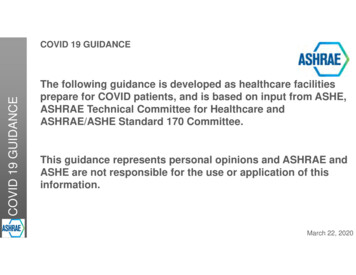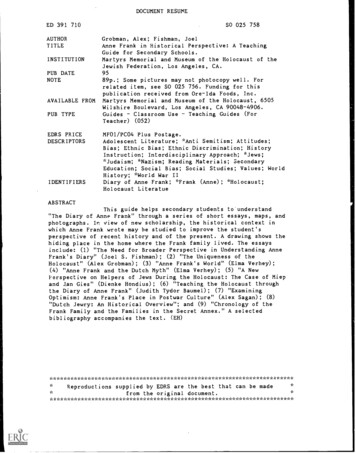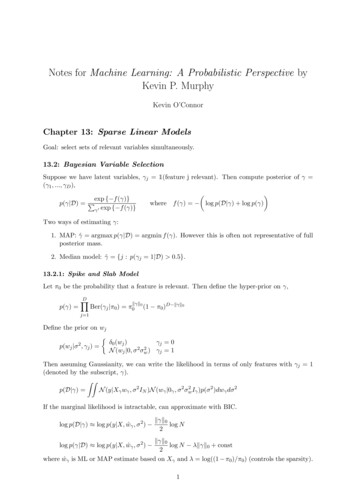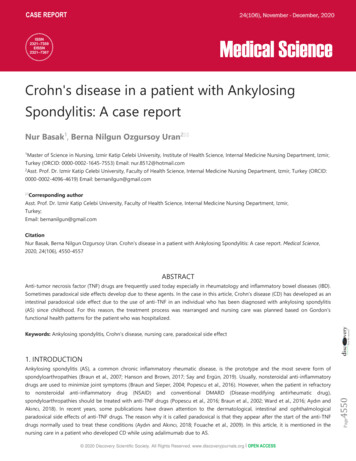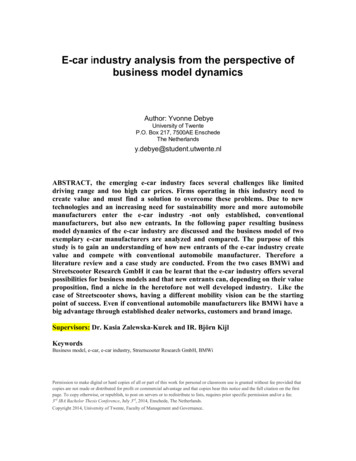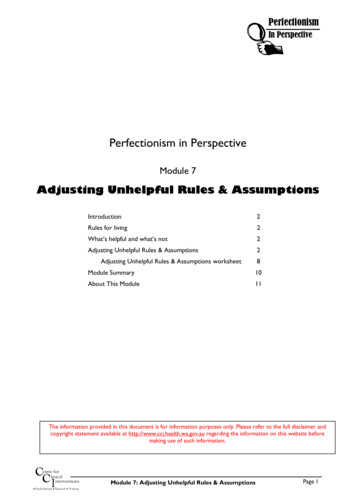
Transcription
PerfectionismIn PerspectivePerfectionism in PerspectiveModule 7Adjusting Unhelpful Rules & AssumptionsIntroduction2Rules for living2What’s helpful and what’s not2Adjusting Unhelpful Rules & Assumptions2Adjusting Unhelpful Rules & Assumptions worksheet8Module Summary10About This Module11The information provided in this document is for information purposes only. Please refer to the full disclaimer andcopyright statement available at http://www.cci.health.wa.gov.au regarding the information on this website beforemaking use of such information.forCentrelinicalC Interventions Psychotherapy Research TrainingModule 7: Adjusting Unhelpful Rules & AssumptionsPage 1
PerfectionismIn PerspectiveIntroductionYou have now learned strategies to reduce your perfectionism behaviours (Module 5) and challenge yourperfectionistic thinking (Module 6). At this point you have the tools to work on having your life lesscontrolled by your unrelenting high standards. We hope you are enjoying the benefits! However, you maystill wish to work on the underlying issues that influence your perfectionism. It is not always necessary towork on the underlying reasons in order to overcome perfectionism but there may be some addedbenefits. Remember that the underlying issues are more entrenched and difficult to shift so this may takemore intensive work with a mental health professional specialising in cognitive-behavioural therapy. In anycase, here are some strategies to get you started. We will focus on your unhelpful rules and assumptionsthat keep you caught in the vicious cycle of perfectionism.Rules for livingAs we mentioned in Module 2, we all have rules by which we live our lives. Although we aren’t specificallytaught rules, we learn them through our early experiences and from observing other people who influenceus in our early years. You may not even be aware that you developed these rules but they consistentlyinfluence your behaviour anyway. They are different from automatic thoughts in that they guide ourbehaviour explicitly.Rules for Living: What’s Helpful and What’s NotAs we’ve mentioned earlier, some rules are healthy and helpful and some are not. We all need rules forliving to help us make sense of the world and to cope with our everyday lives. So having rules, in itself, isnot a bad thing. Helpful rules are realistic, flexible and adaptable. An example of a healthy rule is thatdrivers should stop at red lights. This is a helpful rule because there is evidence to suggest that notstopping at a red light may result in a car accident. So keeping this rule can help ensure our survival!Helpful rules are also flexible and adaptable and this helps us to adapt our behaviour to different situations.For example, having the rule that “it is good to try to eat healthy food” is helpful because there is evidenceto support the fact that you will have fewer health problems if you eat healthy foods. But there is alsoflexibility in this rule so that it takes into account occasions when it may be preferable to eat foods that areless healthy (e,g,, birthdays or Christmas) without feeling guilty.Unhelpful rules are those that are inflexible, rigid, and unreasonable. For example, holding the belief “Imust never make mistakes” is unreasonable in the sense that it is unlikely that we would be able tomaintain this standard and this means we are likely to feel bad when we made any mistake. It is notpossible or reasonable to expect yourself to “never” make a mistake so this type of unhelpful rule will onlykeep you feeling bad about yourself.Therefore we need to view helpful rules as guidelines which help us function in the world. Let’s have a lookat how we can adjust unhelpful rules so that they are more realistic and flexible.Adjusting Unhelpful Rules & AssumptionsWhen generating a more helpful rule or assumption, this involves thinking of another way to see yourselfand the world that is more balanced, flexible to different circumstances, and realistic given the real state offorCentrelinicalC Interventions Psychotherapy Research TrainingModule 7: Adjusting Unhelpful Rules & AssumptionsPage 2
PerfectionismIn Perspectiveaffairs. When thinking of how to put the new rule or assumption into practice, this involves working outhow you would act in everyday life if you already believed the new helpful rule or assumption, and thenmaking a point of acting that way. Often when we act as if something were true, we actually start to take iton board and believe it.To challenge your unhelpful rules and assumptions about your perfectionism, there are six steps to take.You will need to: Clearly identify what your unhelpful rule or assumption is Work out where it comes from or how it developed Question whether your rule is realistic or reasonable or achievable Recognise the negative consequences of having and keeping this rule Identify a more helpful rule or assumption you could try to adopt Plan how you would need to act in every day life to put this new helpful rule or assumption intopracticeIn Module 2 we identified some rules and assumptions common to perfectionists. Now we will look atthem again, showing the steps to follow in order to adjust them. Read through the examples below to getan idea of how to complete the steps. On Page 8 you will find a worksheet to guide you through the stepsfor your own unhelpful rules and assumptions.Fear of FailureWhat is the unhelpful rule of assumption I would like to adjust?It could be:I must do things perfectlyI must not failI can’t have others think poorly of meIf I try, then I will only failIf I put my work out there, then others will think badly of meWhere did this rule or assumption come from?It might be from:Messages I received from my family (e.g., “It’s not worth doing something if you don’t do itperfectly”, or, “People who don’t do well are failures”)Past experiences of having failed and having negative consequences of thisRecent experiences of seeing how successful people are admired and unsuccessful people are notIn what ways is this rule or assumption unreasonable? Unrealistic? Unfair?It’s impossible to do anything absolutely perfectly all the time. It is reasonable to think that I’ll be good atsome things and not so good at others. Making some mistakes is normal. I can’t always control whatothers think of me. If I never even try, then I won’t know whether or not I can succeed.What are the negative consequences of having this rule or assumption?If I think I can’t do something perfectly then I sometimes don’t even try. I put things off because I’m afraidto fail. I have to work SO hard and for SO long in order to get things just right. I never have any free time.What is an alternative, more helpful and balanced rule or guideline?Possibilities include:Not being perfect doesn’t mean being a failureTrying my best is reasonable – in some areas I’ll do well, and in others I’ll do less wellIt’s OK to do things well rather than ‘perfectly’forCentrelinicalC Interventions Psychotherapy Research TrainingModule 7: Adjusting Unhelpful Rules & AssumptionsPage 3
PerfectionismIn PerspectiveWhat can I do to put this rule or assumption into practice daily?Make a spelling mistake on purpose to see if people criticise me – or even if they notice! Find some timefor relaxation. Remind myself that it’s not possible to be perfect. Ask for some constructive criticism andpractice being able to tolerate it.Shoulds, musts, and all-or-nothing thinkingWhat is the unhelpful rule of assumption I would like to adjust?It could be:I must make sure that every room in my house is always spotlessly cleanI must always complete my work quickly or my boss will think I am incompetentIf I eat anything at all before noon, it’s proof I have no willpowerI can’t eat any chocolate or I might lose all control and bingeWhere did this rule or assumption come from?It might be from:My mum always made me keep my bedroom spotlessWe were never allowed any chocolate, so when I did get some, I’d eat it all secretly and quicklyIn what ways is this rule or assumption unreasonable? Unrealistic? Unfair?Some of the demands I impose on myself are impossible to achieve. I see things as black and white, whereasother people see shades of grey.What are the negative consequences of having this rule or assumption?I set myself up to try to achieve the impossible. I give up if I’m not totally in control or successful. I putmyself under tremendous pressure. When I don’t meet my goals, I’m very critical and I blame myself.What is an alternative, more helpful and balanced rule or guideline?Possibilities include:It’s good to try hard, but you have to be adaptable.If I don’t achieve something completely, it’s OKWhat can I do to put this rule or assumption into practice daily?Practice not doing something as soon as I feel I ‘should’ – delay it for one day or even one hour. Considershades of grey and set my standards more leniently.Constant CheckingWhat is the unhelpful rule of assumption I would like to adjust?It could be:I have to weigh myself every day to make sure my weight hasn’t gone upI must check my reports over and over to make sure there are no errorsI have to go over conversations in my mind to make sure I didn’t say anything wrongI have to look in the mirror every time I pass one, to make sure my make-up and hair are OKWhere did this rule or assumption come from?It might be from:My parents were anxious, checking their watches so they wouldn’t be late, making sure the gasstove was turned off, checking the front door was lockedI once went out with my mascara all smeared and everyone laughed at me and I felt such a foolforCentrelinicalC Interventions Psychotherapy Research TrainingModule 7: Adjusting Unhelpful Rules & AssumptionsPage 4
PerfectionismIn PerspectiveIn what ways is this rule or assumption unreasonable? Unrealistic? Unfair?You can’t control everything. Checking things that have already happened doesn’t change the past.However much you check, there might be an error you miss.What are the negative consequences of having this rule or assumption?Checking things over takes up a lot of time. However much I check, I still feel anxious.What is an alternative, more helpful and balanced rule or guideline?Possibilities include:It’s good to check that things are OK, but checking once should be enoughIt’s not the end of the world if something is not 100% rightWhat can I do to put this rule or assumption into practice daily?Practice reducing my checking. Make a deal with myself to check my face/the stove/my report only once.Self-controlWhat is the unhelpful rule of assumption I would like to adjust?It could be:I won’t let myself relax because if I do, I may become lazyI can never go out and have fun because I can’t take time off from my studiesI won’t let myself have a treat because I haven’t worked hard enough for itI won’t eat bread because that way I know I’m strongWhere did this rule or assumption come from?It might be from:My father was a workaholic and never took time off from workI used to be overweight and I swore I’d never let myself get like that againIn what ways is this rule or assumption unreasonable? Unrealistic? Unfair?I have to work tremendously hard in order to let myself stop - it’s silly to say that I don’t deserve a treat.It’s unreasonable to tell myself I shouldn’t relax. Eating a piece of bread doesn’t really mean I’m strong.What are the negative consequences of having this rule or assumption?I never get to have any fun. I never get to ‘chill out’. I’m too hard on myself.What is an alternative, more helpful and balanced rule or guideline?Possibilities include:If I work hard, I deserve to rest and to treat myself, even if I haven’t finished all my tasksIt’s OK to relax occasionally and it doesn’t mean I’m lazyBeing in control is about making choices that are good for me, not about limiting my choicesWhat can I do to put this rule or assumption into practice daily?Make sure I relax. Put a time limit on the work I’m doing and stop at that point, however much or little I’veaccomplished. Choose to eat a slice of bread and practice coping with that – remind myself that makinghealthy choices is a healthier way to be in control of myself.Simplicity, structure, controlWhat is the unhelpful rule of assumption I would like to adjust?It could be:I must be certain of what will happenI should be prepared for the worstforCentrelinicalC Interventions Psychotherapy Research TrainingModule 7: Adjusting Unhelpful Rules & AssumptionsPage 5
PerfectionismIn PerspectiveI can’t stand not knowing the outcomeIf I take action, then something bad will happenI am better off not doing anything, than risk it going badWhere did this rule or assumption come from?It might be from:Growing up feeling that the world is a dangerous placeWe moved often and I had to be on guard in strange townsWhen I have taken action, it hasn’t always worked out wellIn what ways is this rule or assumption unreasonable? Unrealistic? Unfair?You can’t be sure about everything. You can only be prepared to a certain extent. You have to take somerisks.What are the negative consequences of having this rule or assumption?I’m on guard all the time. I never feel relaxed.What is an alternative, more helpful and balanced rule or guideline?Possibilities include:Prepare for a variety of possible consequences but be open and flexibleTake calculated risksWhat can I do to put this rule or assumption into practice daily?Practice taking risks – doing something with an unknown outcome, e.g., asking an acquaintance out forcoffee.Setting even more demanding standardsWhat is the unhelpful rule of assumption I would like to adjust?It could be:I had the goal of dieting till I got to 55 kg, but now I’ve got there it doesn’t seem hard enough and Ineed to push myself furtherI had a goal of 90% on my test, and now that I got 90% I need to get 95% next timeI got promoted last year and I must get promoted again this yearWhere did this rule or assumption come from?It might be from:I was brought up to be competitive with my brotherNothing was ever good enough for my parentsI went to a school that pushed you to achieve more and moreIn what ways is this rule or assumption unreasonable? Unrealistic? Unfair?It’s impossible to keep on doing better forever. Making higher demands and resetting the bar – where will itend?What are the negative consequences of having this rule or assumption?No achievement is ever satisfying. I push and push myself and for no reward. I beat myself up for not doingbetter.What is an alternative, more helpful and balanced rule or guideline?Possibilities include:Setting achievable, appropriate goals is healthyReaching a goal is a sign of success and deserves a pat on the backforCentrelinicalC Interventions Psychotherapy Research TrainingModule 7: Adjusting Unhelpful Rules & AssumptionsPage 6
PerfectionismIn PerspectiveWhat can I do to put this rule or assumption into practice daily?Set a goal and don’t move the goalposts! Give myself a pat on the back when I achieve my goal.Now that you have an idea about the steps needed for challenging your unhelpful rules and assumptions, itis time to think about your particular rules and assumptions that you would like to work on. Rememberthat it will take regular practice to change some of your ingrained beliefs, and challenging them is a usefulway to begin. Take a moment and jot down some of your unhelpful rules and assumptions regarding yourperfectionism.You can now give it a go yourself. Overleaf you will find a general worksheet that you can use for each ofthe unhelpful rules and assumptions you would like to work on. Take one at a time, and make sure youspend some time every day practicing, until you feel you are replacing your old unhelpful assumptions withmore balanced rules.forCentrelinicalC Interventions Psychotherapy Research TrainingModule 7: Adjusting Unhelpful Rules & AssumptionsPage 7
PerfectionismIn PerspectiveAdjusting My Unhelpful Rules & AssumptionsWhat is the unhelpful rule or assumption I would like to adjust?Where did this rule or assumption come from?In what ways is this rule or assumption unreasonable? unrealistic? unfair? unhelpful?What are the negative consequences of having this rule or assumption?What is an alternative more helpful (i.e., balanced, flexible, realistic) rule or assumption?What can I do to put this rule or assumption into practice on a daily basis?forCentrelinicalC Interventions Psychotherapy Research TrainingModule 7: Adjusting Unhelpful Rules & AssumptionsPage 8
PerfectionismIn PerspectiveRemember, practice is very important for challenging your perfectionism. We urge you to practice, andremind you that you don’t have to achieve change ‘perfectly’ or even quickly. We encourage you tocontinue the challenge, without the expectation that you will be able to banish all perfectionistic thoughts.Remember, any loosening of your unrelenting standards will bring its rewards. The goal is to reduce yourperfectionism – which is attainable – not to rid your self of all perfectionism!Join us in the next module where we take a step back to look at the impact of perfectionism, specifically onyour over-evaluation of achievement and more generally on the way you view yourself and the world.forCentrelinicalC Interventions Psychotherapy Research TrainingModule 7: Adjusting Unhelpful Rules & AssumptionsPage 9
PerfectionismIn PerspectiveModule Summary We all have rules for living; some rules are helpful and some are notUnhelpful rules and assumptions can maintain perfectionismAdjusting your unhelpful rules and assumptions requires going through certain steps in order tochallenge themPractice is important, in order to shift old established messages and beliefsLiving with more balanced rules and assumptions allows you to have more choices in life and feel morecontentedWhat I Have Learned in this ModuleThink about what you have learned in this module and any useful bits of information, tips or strategies thatyou want to remember. Write them down below so you can refer to them later.Think about how you might use the information you have just learned. Write down some ways in whichyou could make use of this information.Coming Up In Module 8 (Re-evaluating achieving) we will be looking at theimpact of over-evaluating achievement and the perfectionismmindsetforCentrelinicalC Interventions Psychotherapy Research TrainingModule 7: Adjusting Unhelpful Rules & AssumptionsPage 10
PerfectionismIn PerspectiveAbout this ModuleCONTRIBUTORSDr. Anthea Fursland (Ph.D.1)Principal Clinical PsychologistCentre for Clinical InterventionsDr. Anna Steele (Ph.D.1)Clinical PsychologistCentre for Clinical InterventionsDr. Bronwyn Raykos (M.Psych2,, Ph.D.1)Clinical PsychologistCentre for Clinical InterventionsDr. Lisa Saulsman (M.Psych2, Ph.D.1)Clinical PsychologistCentre for Clinical Interventions1Doctor of Philosophy (Clinical Psychology)2Master of Psychology (Clinical Psychology)BACKGROUNDThe concepts and strategies in this module have been developed from evidence-based psychologicaltreatment, primarily Cognitive Behaviour Therapy (CBT). CBT for perfectionism is based on the approachthat perfectionism is the result of problematic cognitions (thoughts) and behaviours.REFERENCESAntony, M. M. & Swinson, R. P. (1998) When Perfect Isn’t Good Enough. New Harbinger Publications,Oakland, Ca.Kearns, H., Forbes, A., & Gardiner, M. (2007). A cognitive behavioural coaching intervention for thetreatment of perfectionism and self-handicapping in a nonclinical population. Behaviour Change, 24 (3), 157172.Shafran, R., Cooper, Z. and Fairburn, C. G. (2002) Clinical Perfectionism: a cognitive-behavioural analysis.Behaviour Research and Therapy, 40, 773-791“PERFECTIONISM IN PERSPECTIVE”This module forms part of:Fursland, A., Raykos, B. and Steele, A. (2009). Perfectionism in Perspective. Perth, Western Australia: Centrefor Clinical Interventions.ISBN: 0-975799576forCentrelinicalC Interventions Psychotherapy Research TrainingCreated: March 2009Module 7: Adjusting Unhelpful Rules & AssumptionsPage 11
Perfectionism In Perspective affairs. When thinking of how to put the new rule or assumption into practice, this involves working out how you would act in everyday life if you alre

